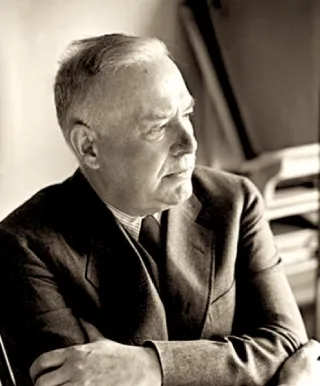Biography of Wallace Stevens

| date | place | |
|---|---|---|
| born | October 02, 1879 | Reading, Pennsylvania |
| died | August 02, 1955 | Hartford, Connecticut |
Wallace Stevens was born on October 2, 1879, in Reading, Pennsylvania, the son of a lawyer. He studied at Harvard (1897–1900), later earned a law degree from New York Law School (1903), and began a legal/insurance career in New York. In 1916 he joined Hartford Accident and Indemnity Company in Connecticut and eventually became vice president in 1934—the famous “insurance executive by day, poet by night” contrast that shaped his public image. In 1909 Stevens married Elsie Viola Kachel (Moll); their daughter Holly was born in 1924 and later edited his letters and helped frame his legacy. The household was private and decorous by design—Stevens maintained a strict routine in Hartford, walking to work and writing in the evenings and on weekends. He died in Hartford on August 2, 1955, after treatment for stomach cancer. Some accounts note a late-life Catholic baptism at the hospital; biographers treat it cautiously, but it remains part of the end-of-life record. Business trips and winter stays in Key West, Florida during the 1920s–30s left clear marks on his poems—think “The Idea of Order at Key West,” “Farewell to Florida,” “O Florida, Venereal Soil.” Florida’s color, sea-light, and music helped catalyze Stevens’s ongoing argument between imagination and reality. His Key West years even produced notorious run-ins with Frost and Hemingway, but their real importance is the way the place sharpened his senses and themes, giving him coastal light, wind, and song as touchstones for thinking about perception. Stevens’s first book, Harmonium (1923), eventually became a cornerstone of American modernism. Major honors arrived late: the Bollingen Prize (1949); National Book Award (1951) for The Auroras of Autumn; and a second National Book Award plus the Pulitzer Prize (1955) for The Collected Poems of Wallace Stevens. The timeline matters: he wrote steadily while keeping a demanding day job, and recognition gathered as his late style clarified and broadened. Stevens is a central American modernist whose poems stage a clear, musical contest between the mind’s imagination and the world’s facts. He is often called a philosophical lyric poet: precise diction, exacting sound, and meditative argument that still feels sensuous and visual. Core subjects include how reality changes as we look at it; how art orders chaos; and how belief, stripped of dogma, can become an “idea of order” we can live inside. Early and lasting influences include the French Symbolists (especially Mallarmé and Valéry) and, in philosophy, George Santayana—sources for his interest in perception, abstraction, and the mind’s “supreme fiction.” His debut collection Harmonium (1923) contains touchstone poems—“Sunday Morning,” “The Snow Man,” “Thirteen Ways of Looking at a Blackbird,” “Anecdote of the Jar.” Later volumes (Ideas of Order, The Man with the Blue Guitar, Parts of a World, Transport to Summer, The Auroras of Autumn) extend his crystalline diction, exacting music, and speculative poetics, often returning to the same problems—faith without theology, the pressure of reality, the pleasures and limits of imagination—with new figures, new scenes, and a cooler late grandeur. Wallace Stevens died in Hartford, Connecticut, on August 2, 1955, after a months-long illness with stomach cancer. He had been hospitalized at St. Francis Hospital, underwent treatment and a surgery that spring, was briefly discharged, then readmitted as his condition worsened. Accounts note that in his final months he received the Pulitzer Prize for The Collected Poems and an additional National Book Award; near the end, a hospital chaplain reported that Stevens accepted Catholic baptism, a claim later disputed by his daughter and some biographers. Stevens was 75 and was buried at Cedar Hill Cemetery in Hartford. His reputation since has only grown: readers return to him for the lucid strangeness of “The Snow Man,” the kaleidoscopic angles of “Thirteen Ways of Looking at a Blackbird,” and the sea-lit meditations of “The Idea of Order at Key West,” finding in his work a durable introduction to modernist poetry and a lasting example of how thought and sensation can meet in the American lyric.
Feel free to be first to leave comment.